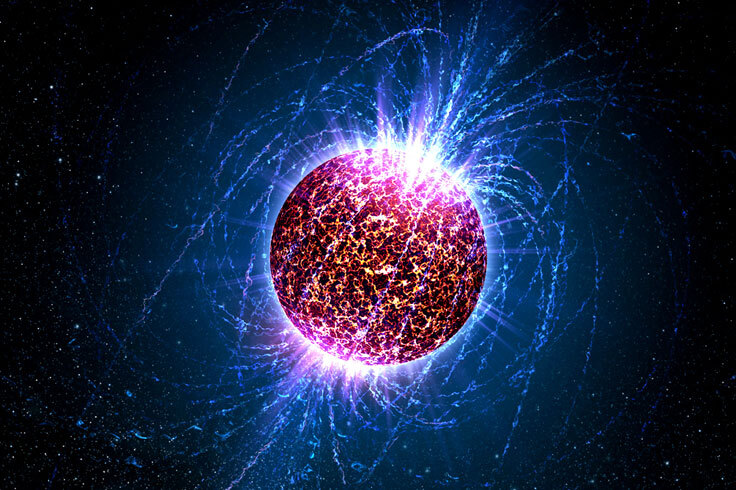21.07.2023
An unidentified source has been beaming out a pulse of radio waves every 22 minutes since 1988.

An artist's illustration of a pulsar
Casey Reed / Penn State University
Astronomers have found an ultra-slow, long-lasting source of radio-wave pulses, and they are perplexed as to its true nature. While “regular” radio pulsars have very short periods, from seconds down to just a few milliseconds, this source emits a brief pulse of radio waves about three times per hour. What’s more, it has been doing this for decades.
“I do not think we can say yet what this object is,” says Victoria Kaspi (McGill University), a pulsar researcher who was not involved in the new study.
Natasha Hurley-Walker (Curtin University, Australia) and her colleagues discovered the mysterious source in data from the Murchison Widefield Array (MWA) observatory in Western Australia. They carried out follow-up observations with the MWA and with other radio observatories in Australia and South Africa. Known as GPM J1839-10, the tardy blinker is located at a distance of some 18,500 light-years away in the constellation Scutum. Archival data from the Very Large Array in New Mexico and the Indian Giant Metrewave Radio Telescope reveal that it has been pulsating at least since 1988, with a period of just under 22 minutes (1,318.1957 seconds, to be precise).

NRAO
Pulsars are magnetized neutron stars that emit beams of particles and radiation from their magnetic poles; their rapid spin sweeps these beams through space. When a beam swings by our direction, we see a brief pulse of radio waves. But if neutron stars are rotating too slowly, they’re not expected to generate such lighthouse-like beams. The authors note in this week’s Nature that a classical pulsar explanation is “barely viable.”
Very strongly magnetized neutron stars known as magnetars have slower spin periods and can sometimes produce long-period radio pulses for a while following energetic outbursts. For instance, the same team found another slow pulsator in archival data last year. Known as GLEAM-XJ162759.5-523504.3, it has an 18.18-minute period. However, it faded within three years, while the new discovery, GPM J1839-10, has been pulsating for decades on end.
The new one also exhibits some strange behavior, says team member Nanda Rea (Institute of Space Sciences, Spain). “Such a slow magnetar should be bright in X-rays, which we have not detected,” she notes. “Both the object’s [long-term] activity and its long periodicity are unseen in any known astrophysical sources.”
The team proposes an alternative scenario: a strongly magnetized and isolated white dwarf star. Because it’s spinning a larger mass, a magnetized white dwarf could potentially still generate beams of energetic particles even if it has a relatively slow rotation rate. There’s one problem, though: Astronomers know of many nearby, isolated white dwarfs, and none of those have ever showed such bright radio emission, let alone in the form of pulses.
Kaspi, who wrote an accompanying perspective piece in the same issue of Nature, isn’t ready yet to give up on the “classical” pulsar explanation for GPM J1839-10. “Nature can be more inventive than astrophysical theorists,” she says. “The physics of radio pulsar magnetospheres is very rich and there is room for modifications.
“Still,” she adds, “I like the white dwarf model, mainly because it is testable.”
Indeed, very deep observations at visible and infrared wavelengths, either with large ground-based telescopes or with the James Webb Space Telescope, might reveal a counterpart at these wavelengths, notes Rea. “This is our next challenge.”
Quelle: Sky&Telescope
